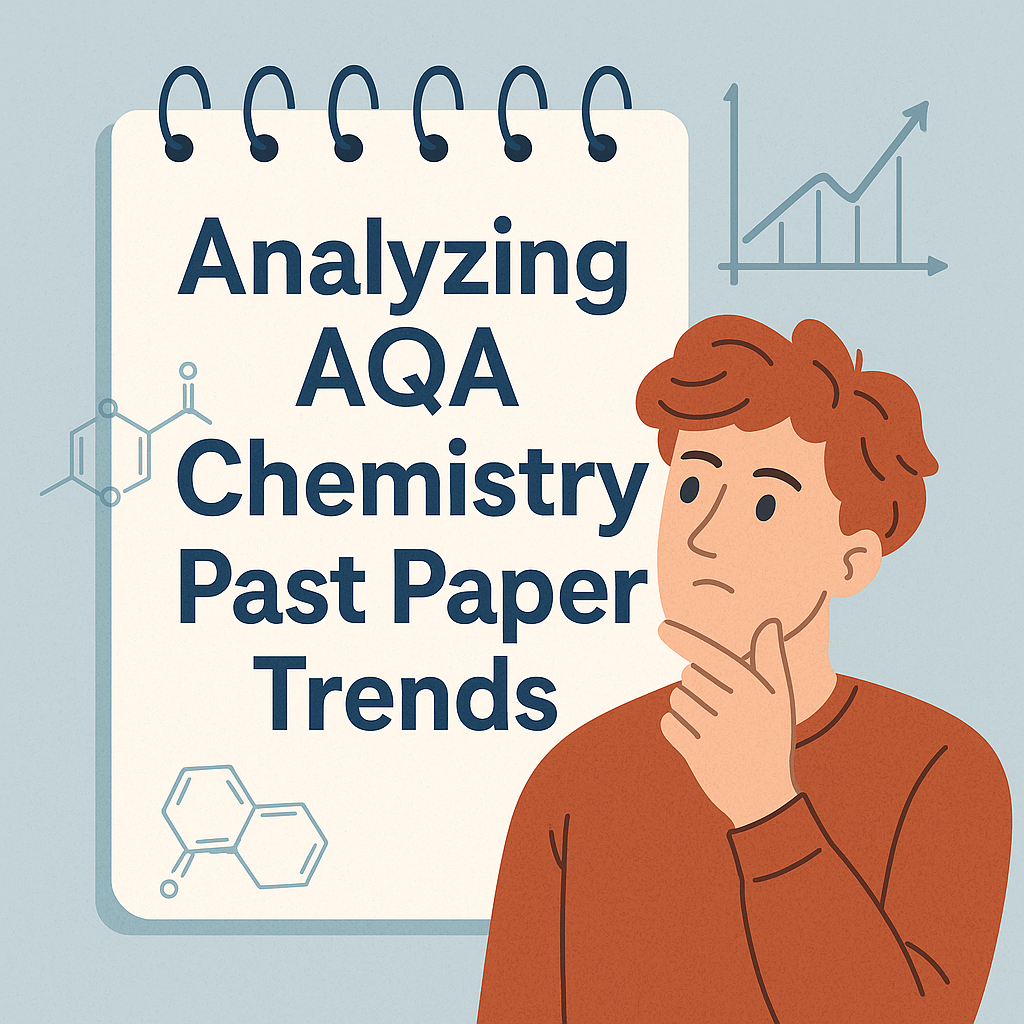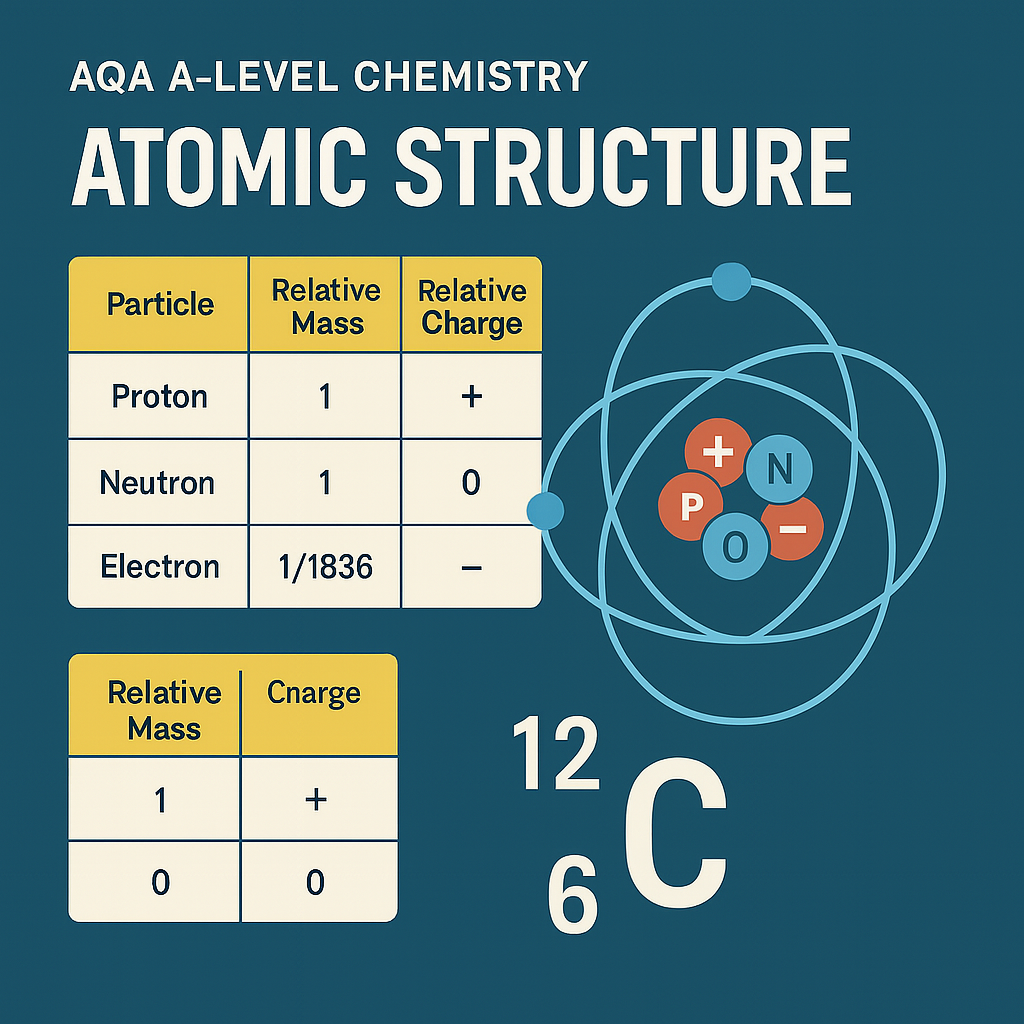Analyzing AQA Chemistry Past Paper Trends: What They Reveal and How to Use Them to Boost Your Grade
Analyzing AQA past paper trends gives you a map. It shows what’s likely to come up, how to prepare, and how to think like an examiner.
If you’re preparing for AQA GCSE or A-Level Chemistry, past papers aren’t just for practice—they're a powerful diagnostic tool. By reviewing how topics are assessed year after year, you can spot patterns, understand examiner expectations, and refine your revision strategy.
In this blog, we’ll explore trends in AQA Chemistry past papers, show you how to analyse them like an examiner, and explain how this insight can help you maximise marks in 2026.
Why Past Paper Analysis Matters for AQA Chemistry
Most students use past papers to test their knowledge. But high-achieving students go a step further: they use past papers to predict themes, identify question formats, and practise exam technique in a targeted way.
With AQA Chemistry, trends tend to emerge over time:
Certain topics appear almost every year
Question types follow predictable formats
Some command words are reused frequently
There’s often a thematic structure to each paper
Some years focus more on data analysis, others on calculations
By studying past papers across multiple years, you gain a strategic advantage that goes beyond memorisation.
What This Blog Covers
In this guide, we’ll cover:
A breakdown of recent AQA Chemistry GCSE and A-Level papers
Recurring themes and question styles
Topics that appear most frequently
Trends in practical skills and required calculations
How to use this insight to tailor your revision and exam practice
Understanding the AQA Exam Structure
AQA GCSE Chemistry (8462):
Paper 1: Atomic structure, bonding, quantitative chemistry, chemical changes, electrolysis, energy changes
Paper 2: Rates of reaction, organic chemistry, analysis, atmosphere, using resources
Each paper: 1 hour 45 minutes, 100 marks, 50% of GCSE
AQA A-Level Chemistry (7405):
Paper 1: Physical + Inorganic Chemistry (year 1 content)
Paper 2: Physical + Organic Chemistry (year 2 content)
Paper 3: Synoptic and practical-based questions
Each paper: 2 hours, 35% for Papers 1 & 2, 30% for Paper 3
Part 1: GCSE Chemistry Trends – What Keeps Coming Up
1. Electrolysis Questions Are Common in Paper 1
From 2018–2023, electrolysis has appeared in some form in every Paper 1.
Frequently tested aspects include:
Predicting products from molten/aqueous electrolysis
Half-equations
Practical setup and lab analysis
🧠 Tip: Make sure you know the reactivity series and how to decide which ions are discharged.
2. Bonding and Structure Appear Nearly Every Year
Bonding questions test:
Ionic, covalent, and metallic bonding
Giant lattice vs simple molecular
Structure-property relationships
Questions often involve diagrams or comparisons.
🧠 Tip: Be ready to compare different types of bonding and justify physical properties (e.g. boiling points).
3. Required Practicals Are Integrated Throughout
Don’t expect a “practicals only” question. AQA frequently embeds practical skills into general questions:
Titrations
Chromatography
Rates of reaction
Electrolysis
🧠 Tip: Be able to describe a method clearly and use key terms like control variables, repeat readings, and validity.
4. Calculation Questions Are Consistent
Calculation types you must know:
Moles = mass / Mr
% yield and atom economy
Concentration = moles / volume
Titration (for triple science)
Energy changes (Q = mcΔT)
These appear every year and often carry 4–6 marks.
🧠 Tip: Always show your working and check units carefully.
5. Environmental Chemistry Features Regularly in Paper 2
Greenhouse gases
Global warming
Pollution
Sustainable development
Life Cycle Assessments (LCA)
🧠 Tip: Learn both the science and the language of evaluation (e.g. advantages/disadvantages of plastics or biofuels).
Part 2: A-Level Chemistry Trends – What the Data Shows
1. The Big Five Topics Appear in Every Year
Across 2018–2023 AQA A-Level Chemistry past papers, the following areas have shown up consistently across Papers 1 and 2:
Equilibria: Le Chatelier’s Principle, Kc, Kp
Energetics: Enthalpy cycles, bond enthalpies, Hess’s Law
Organic Mechanisms: Nucleophilic substitution, electrophilic addition, elimination
Acids and Bases: pH calculations, buffers, Ka
Redox and Electrode Potentials: Balancing equations, calculating EMF, predicting feasibility
🧠 Tip: These are “core topics”—expect them in both structured and multi-topic questions.
2. Paper 3 Follows a Synoptic Style With Practical Contexts
Paper 3 is known for:
Data analysis
Experimental design
Unexpected combinations of topics
Application of required practicals
Common features include:
Graph-based questions
Multi-part calculation chains
Justifying conclusions from experimental data
🧠 Tip: Be ready to link concepts—e.g., explain why a buffer was used in a titration or evaluate a yield based on Le Chatelier’s principle.
3. Spectroscopy Is a Regular Feature in Organic Questions
Spectroscopy shows up every year—especially:
Mass spectrometry
IR spectroscopy
NMR in Paper 2 and Paper 3
Questions often involve:
Peak identification
Molecular structure deduction
Drawing or naming compounds
🧠 Tip: Don’t just memorise peaks—practise interpreting full spectra and combining them with empirical/molecular formula data.
4. Mechanisms Are Assessed Every Year
Organic mechanisms—drawn correctly—are a must.
Commonly tested ones include:
SN1 and SN2 nucleophilic substitution
Electrophilic addition to alkenes
Elimination reactions
Friedel-Crafts (for A2 students)
🧠 Tip: Use clear curly arrows, correct charges, and product structures. Many students lose marks here due to diagram errors.
5. Calculations Often Mix Concepts
HL papers increasingly test calculation fluency, e.g.:
Combining enthalpy and equilibrium
Using Ka to find pH of weak acids
Multi-step mole and volume problems
🧠 Tip: Practise showing working clearly and checking sig figs. AQA is strict on structure in calculation questions.
Part 3: What Students Miss When Revising Past Papers
While reviewing past papers is essential, many students:
❌ Only do the last year’s paper
❌ Skip the mark schemes
❌ Don’t track which topics they’re struggling with
❌ Don’t learn how the same topic is asked in different ways
If you want to turn past papers into a powerful revision tool, you need to analyse them strategically.
How to Analyse AQA Chemistry Past Paper Trends Like a Pro
✅ Step 1: Create a Topic Frequency Log
Download papers from 2018–2023 and create a table listing:
Topic
Year
Which paper it appeared in
Marks allocated
This shows you which areas come up most often and how heavily they’re weighted.
✅ Step 2: Group Questions by Topic
Rather than completing full papers first, try:
Doing all calculation questions across five years
Doing all IR spectroscopy questions back to back
Tackling all equilibrium or redox questions together
This reinforces patterns and reveals what examiners consistently focus on.
✅ Step 3: Study the Mark Schemes
Don’t just check if you got it right—ask:
What exact wording did they reward?
What mistakes did I make in how I explained it?
Was there an easier way to answer?
This is how you learn examiner language and improve precision.
✅ Step 4: Build a Mistake Tracker
Create a spreadsheet or notebook to track:
The topic
The error
Why it happened
What to do next time
Over time, you’ll spot patterns in your weaknesses and start to fix them systematically.
✅ Step 5: Time Yourself Under Exam Conditions
Once you’ve completed topic-based practice, shift to full-paper timing:
Paper 1 = 2 hours
Paper 2 = 2 hours
GCSE Papers = 1 hour 45 minutes
Use a timer, minimise distractions, and mark yourself strictly.
How This Strategy Helps Raise Your Grade
Past paper trend analysis isn’t just about prediction—it’s about pattern recognition. It gives you:
A more focused revision plan
Confidence in tackling recurring question types
Improved time management
Precision in how you explain and calculate
A higher probability of gaining “easy marks” that others miss
Final Thoughts: Exam Success Comes From Strategy, Not Just Knowledge
If you want a grade 7–9 in GCSE Chemistry or an A/A* at A-Level, you need more than content—you need exam strategy. Analyzing AQA past paper trends gives you a map. It shows what’s likely to come up, how to prepare, and how to think like an examiner.
Need Help With AQA Chemistry Past Paper Strategy?
Book a free consultation with Dr Marguerite Quinn, expert online chemistry tutor with 3,000+ hours of experience helping students master exam technique. Whether you need help with paper analysis, calculation fluency, or unlocking grade 8/9 answers, Marguerite can guide you step-by-step.





Understand AQA A-Level Chemistry Section 3.1.1.2 on mass number and isotopes. Learn key definitions, isotope notation, calculations, and how this topic builds your scientific and exam skills.